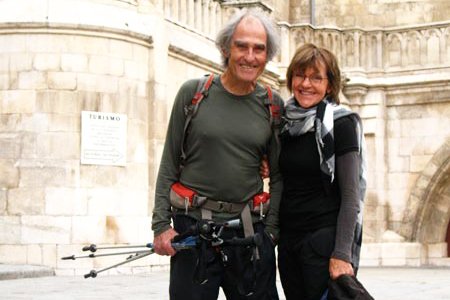My Personal "Hajj": El Camino de Santiago
 El Camino de Santiago, or in English, the Way of St. James, is a series of historical pilgrimage routes through Spain, dating back more than 1,000 years. The routes all end at the city of Santiago de Compostela in northwest part of the country. I took the most travelled route, known as the French Way (or the Camino Frances), which starts at the town of St-Jean-Pied-de-Port on the French side of the Pyrenees. In 2010, which was a Holy or Jubilee Year for Catholics, more than 250,000 people made the trek. Why?Since, historically, it has been a religious pilgrimage, many assume that people do the walk for religious or spiritual reasons. Although many walk the Camino at turning points in their lives, people give varied reasons for their journey. I feel that the reasons correlate generally with the age of the pilgrim (we were called pilgrims, or "peregrinos" while we walked). Many of the 22- to 25-year-old pilgrims were taking time off to travel the world, or to decide what they wanted to do with their lives, didn't have much money, and were walking the Camino as an inexpensive trip (they say you can walk the Camino for €1 — about US$1.35 — per kilometer). The 28- to 45-year-olds were the ones who were dissatisfied with their current work or life or partner, were searching for meaning, and were walking to have time to think. I talked to several in this group, and generally they held, or had held, very demanding jobs, which were not personally gratifying, or which had taken over their entire lives. The above-50 pilgrims gave more complex reasons. Several women said they had repeatedly chosen dysfunctional men as their life partners, but had made a decision to change this pattern, and were walking the Camino as the starting point for the beginning of the change. One or two Americans had just taken early retirement, and were taking time out to celebrate before they started their post-retirement lives. A good number of people (especially the Germans and Scandinavians) were walking just for the challenge of it. Why was I doing it? Well, I didn't really have a specific reason, but I told people I was doing it to celebrate the fact that my husband and I still liked each other after being married for a long time, and that our three children had grown up without ever having been put in jail. What was it like?Every day is the same: breakfast at 7:30; on the trail by 8:00 or 8:30; walk an average of 25km (every day, usually taking six to eight hours); stop for drinks in the frequent cafe-bars along the Camino; tend your poor, suffering feet at the end of the day; celebrate the completion of another 25km (the Spanish Rioja is terrific!); collapse into bed by 9:00; sleep the best sleep you've ever had. The Camino is perfectly groomed and is very well marked. The countryside is more barren at the beginning, but becomes hilly, and even mountainous and green as you approach Santiago de Compostela. You pass through beautifully restored ancient villages with fabulous 900-year-old churches. The hotels and hostels are meticulously clean, as are the bathrooms along the Camino (this really impressed me). Most of the people sleep in a hostel (which are frequently old monasteries) for between €3-5 per night. It is important to pack a minimalist backpack. At the beginning, you will be washing your pants and socks every two to three days, but shortly thereafter, you will wear them for a disgustingly long period between washings. Although you will say "Bon Camino" to everyone you meet or pass, you can talk to people or you can choose not to. We kept encountering, and came to know, several pilgrims who were also walking the entire 800km of the Camino. (Many Europeans will only walk small portions at a time, say, two to three weeks each trip, until they cover the entire route.) After the first three days of walking, when my every leg muscle was screaming with pain, and I felt I must be crazy to punish myself so, the main hardships were blisters and hot, burning soles. Some pilgrims even hobbled along on their blister-covered feet, wearing flip-flops. The other problem is language: For the first 750km, the Spanish people (in the shops, hotels, etc.) spoke absolutely no English. Some spoke a little French, but no English. This really surprised me. The Camino ends in the historic city of Santiago de Compostela, a UNESCO World Heritage Site. This city of 95,000 inhabitants, with its famous cathedral, is the traditional resting place of the Apostle St. James. The cathedral is enormous, and Mass for the pilgrims was celebrated four times per day. Both non-Catholics and Catholics attend. With the high tenor chanting, the wonderful pipe organ, and the spectacular swinging of the huge incense burner, the priests succeeded in making the end of the Camino a dramatic, moving, and yes, spiritual celebration. Post-ScriptI have many memories of my sojourn on the Camino de Santiago:
And yes, I am now trying to organize my life, so I don't let everyday occurrences rattle me, and lose the sense of tranquility I felt while walking the Camino. Helen Ziegler Most Popular |
Related |
Copyright (C) 2026 Helen Ziegler and Associates. All rights reserved.



